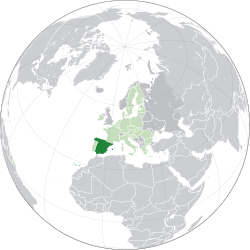
Back Испаниа Abkhazian Seupanyo ACE Испание ADY Spanje Afrikaans Spanien ALS እስፓንያ Amharic Spain AMI Espanya AN Spēonland ANG स्पेन ANP
Kingdom of Spain | |
|---|---|
| Motto: Plus ultra (Latin) (English: "Further Beyond") | |
| Anthem: Marcha Real (Spanish)[1] (English: "Royal March") | |
Location of Spain (dark green) – on the European continent (green & dark grey) | |
| Capital and largest city | Madrid 40°26′N 3°42′W / 40.433°N 3.700°W |
| Official language | Castilian Spanish[b] (also in national language) |
| Nationality (2020) | |
| Religion (2022)[4] |
|
| Demonym(s) |
|
| Government | Unitary parliamentary constitutional monarchy |
• Monarch | Felipe VI |
| Pedro Sánchez | |
| Legislature | Cortes Generales |
| Senate | |
| Congress of Deputies | |
| Formation | |
• De facto | 20 January 1479 |
• De jure | 9 June 1715 |
| 19 March 1812 | |
| 1 April 1939–1978 | |
| 29 December 1978 | |
| 1 January 1986 | |
| Area | |
• Total | 505,990[5] km2 (195,360 sq mi) (51st) |
• Water (%) | 0.89 (2015)[6] |
| Population | |
• 2024 census | |
• Density | 97/km2 (251.2/sq mi) (120th) |
| GDP (PPP) | 2021 estimate |
• Total | |
• Per capita | $41,736[8] (32nd) |
| GDP (nominal) | 2021 estimate |
• Total | |
• Per capita | $31,178[8] (26th) |
| Gini (2019) | medium · 103rd |
| HDI (2019) | very high · 25th |
| Currency | Euro[d] (€) (EUR) |
| Time zone | UTC±0 to +1 (WET and CET) |
• Summer (DST) | UTC+1 to +2 (WEST and CEST) |
| Note: most of Spain observes CET/CEST, except the Canary Islands which observe WET/WEST. | |
| Date format | dd/mm/yyyy (CE) |
| Driving side | right |
| Calling code | +34 |
| ISO 3166 code | ES |
| Internet TLD | .es[e] |
Spain is a country in Southwestern Europe. It is in the Iberian Peninsula. Spain has borders with France, Portugal, Andorra and Gibraltar. Ceuta and Melilla border with Morocco in North Africa. In Spain's northeast side are the Pyrenees mountains.
The people of Spain are known as Spaniards. They speak Castilian or Spanish (in Spanish, "Castellano", from Castilla, or "Español"). They speak other languages in some parts of the country. They are Catalan, Basque, and Asturian, Galician, Leonese, Aragonese, Aranese Occitan and even Portuguese. The religion of about 56% of the population in Spain is Roman Catholic.
Since 1975, Spain has had a constitutional monarchy. The King of Spain is Felipe VI; he only does what the constitution allows him to. The parliament is called "Las Cortes Generales," and has two bodies: "El Congreso" (The Congress) and "El Senado" (The Senate) and it is chosen by the Spanish people by voting. The Prime minister is Pedro Sánchez. The government and the king's palace are in Madrid, the capital of Spain.
Spain has more than 500,000 square kilometres of land. It is smaller than France, but it is bigger than Germany. Almost fifty million people live in Spain. Spain is divided into 17 autonomous communities (this means that they can decide upon some affairs themselves). Each community has its own government.
Spain is known for flamenco which is usually performed by the Caló.
Spain was a predominant Colonial Empire and had colonies throughout the continents South America, Asia, Oceania and Africa with a large hold of European lands.
Spain was under a dictatorship by
Francisco Franco from 1939 to 1974.
Cite error: There are <ref group=lower-alpha> tags or {{efn}} templates on this page, but the references will not show without a {{reflist|group=lower-alpha}} template or {{notelist}} template (see the help page).
- ↑ Presidency of the Government (11 October 1997). "Real Decreto 1560/1997, de 10 de octubre, por el que se regula el Himno Nacional" (PDF). Boletín Oficial del Estado núm. 244 (in Spanish). Archived (PDF) from the original on 24 September 2015.
- ↑ "The Spanish Constitution". Lamoncloa.gob.es. Archived from the original on 25 March 2013. Retrieved 26 April 2013.
- ↑ "Instituto Nacional de Estadística. Población (españoles/extranjeros) por País de Nacimiento, sexo y año". ine.es. Instituto Nacional de Estadística.
- ↑ CIS."Barómetro de Enero de 2022", 3,777 respondents. The question was "¿Cómo se define Ud. en materia religiosa: católico/a practicante, católico/a no practicante, creyente de otra religión, agnóstico/a, indiferente o no creyente, o ateo/a?".
- ↑ "Anuario estadístico de España 2008. 1ª parte: entorno físico y medio ambiente" (PDF). Instituto Nacional de Estadística (Spain). Archived (PDF) from the original on 24 September 2015. Retrieved 14 April 2015.
- ↑ "Surface water and surface water change". Organisation for Economic Co-operation and Development (OECD). Retrieved 11 October 2020.
- ↑ "INEbase / Estadística Continua de Población (ECP). Datos provisionales". ine.es. Retrieved 1 April 2024.
- ↑ 8.0 8.1 8.2 8.3 "World Economic Outlook Database, October 2020". IMF.org. International Monetary Fund. Retrieved 11 February 2021.
- ↑ "Gini coefficient of equivalised disposable income – EU-SILC survey". ec.europa.eu. Eurostat. Retrieved 3 August 2020.
- ↑ "Human Development Report 2020" (PDF). United Nations Development Programme. 10 December 2019. Retrieved 10 December 2019.
© MMXXIII Rich X Search. We shall prevail. All rights reserved. Rich X Search



